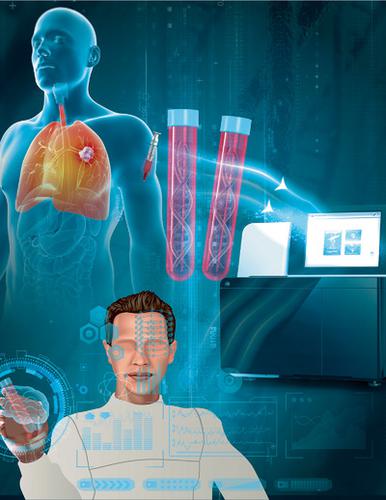当前位置:
X-MOL 学术
›
Laser Photonics Rev.
›
论文详情
Our official English website, www.x-mol.net, welcomes your feedback! (Note: you will need to create a separate account there.)
Photonic Technologies for Liquid Biopsies: Recent Advances and Open Research Challenges
Laser & Photonics Reviews ( IF 11.0 ) Pub Date : 2020-12-02 , DOI: 10.1002/lpor.202000255 Francesco Dell'Olio 1 , Judith Su 2 , Thomas Huser 3 , Virginie Sottile 4 , Luis Enrique Cortés-Hernández 5 , Catherine Alix-Panabières 5
Laser & Photonics Reviews ( IF 11.0 ) Pub Date : 2020-12-02 , DOI: 10.1002/lpor.202000255 Francesco Dell'Olio 1 , Judith Su 2 , Thomas Huser 3 , Virginie Sottile 4 , Luis Enrique Cortés-Hernández 5 , Catherine Alix-Panabières 5
Affiliation

|
The recent development of sophisticated techniques capable of detecting extremely low concentrations of circulating tumor biomarkers in accessible body fluids, such as blood or urine, could contribute to a paradigm shift in cancer diagnosis and treatment. By applying such techniques, clinicians can carry out liquid biopsies, providing information on tumor presence, evolution, and response to therapy. The implementation of biosensing platforms for liquid biopsies is particularly complex because this application domain demands high selectivity/specificity and challenging limit‐of‐detection (LoD) values. The interest in photonics as an enabling technology for liquid biopsies is growing owing to the well‐known advantages of photonic biosensors over competing technologies in terms of compactness, immunity to external disturbance, and ultrahigh spatial resolution. Some encouraging experimental results in the field of photonic devices and systems for liquid biopsy have already been achieved by using fluorescent labels and label‐free techniques and by exploiting super‐resolution microscopy, surface plasmon resonance, surface‐enhanced Raman scattering, and whispering gallery mode resonators. The current state‐of‐the‐art is critically reviewed here, starting from the requirements imposed by the detection of the most common circulating biomarkers. Open research challenges are considered together with competing technologies, and the most promising paths of improvement are discussed for future applications.
中文翻译:

用于液体活检的光子技术:最新进展和开放研究挑战
最近开发的能够检测可及体液(如血液或尿液)中极低浓度的循环肿瘤生物标志物的先进技术可能有助于癌症诊断和治疗的范式转变。通过应用这些技术,临床医生可以进行液体活检,提供有关肿瘤存在、演变和对治疗的反应的信息。用于液体活检的生物传感平台的实施特别复杂,因为该应用领域需要高选择性/特异性和具有挑战性的检测限 (LoD) 值。由于光子生物传感器在紧凑性、对外部干扰的免疫力、和超高的空间分辨率。通过使用荧光标记和无标记技术以及利用超分辨率显微镜、表面等离子体共振、表面增强拉曼散射和回音壁模式,已经在液体活检光子器件和系统领域取得了一些令人鼓舞的实验结果谐振器。从检测最常见的循环生物标志物所提出的要求开始,本文对当前的最新技术进行了严格审查。开放研究挑战与竞争技术一起考虑,并讨论了未来应用最有希望的改进途径。通过使用荧光标记和无标记技术以及利用超分辨率显微镜、表面等离子体共振、表面增强拉曼散射和回音壁模式,已经在液体活检光子器件和系统领域取得了一些令人鼓舞的实验结果谐振器。从检测最常见的循环生物标志物所提出的要求开始,本文对当前的最新技术进行了严格审查。开放研究挑战与竞争技术一起考虑,并讨论了未来应用最有希望的改进途径。通过使用荧光标记和无标记技术以及利用超分辨率显微镜、表面等离子体共振、表面增强拉曼散射和回音壁模式,已经在液体活检光子器件和系统领域取得了一些令人鼓舞的实验结果谐振器。从检测最常见的循环生物标志物所提出的要求开始,本文对当前的最新技术进行了严格审查。开放研究挑战与竞争技术一起考虑,并讨论了未来应用最有希望的改进途径。从检测最常见的循环生物标志物所提出的要求开始,本文对当前的最新技术进行了严格审查。开放研究挑战与竞争技术一起考虑,并讨论了未来应用最有希望的改进途径。从检测最常见的循环生物标志物所提出的要求开始,本文对当前的最新技术进行了严格审查。开放研究挑战与竞争技术一起考虑,并讨论了未来应用最有希望的改进途径。
更新日期:2021-01-08
中文翻译:

用于液体活检的光子技术:最新进展和开放研究挑战
最近开发的能够检测可及体液(如血液或尿液)中极低浓度的循环肿瘤生物标志物的先进技术可能有助于癌症诊断和治疗的范式转变。通过应用这些技术,临床医生可以进行液体活检,提供有关肿瘤存在、演变和对治疗的反应的信息。用于液体活检的生物传感平台的实施特别复杂,因为该应用领域需要高选择性/特异性和具有挑战性的检测限 (LoD) 值。由于光子生物传感器在紧凑性、对外部干扰的免疫力、和超高的空间分辨率。通过使用荧光标记和无标记技术以及利用超分辨率显微镜、表面等离子体共振、表面增强拉曼散射和回音壁模式,已经在液体活检光子器件和系统领域取得了一些令人鼓舞的实验结果谐振器。从检测最常见的循环生物标志物所提出的要求开始,本文对当前的最新技术进行了严格审查。开放研究挑战与竞争技术一起考虑,并讨论了未来应用最有希望的改进途径。通过使用荧光标记和无标记技术以及利用超分辨率显微镜、表面等离子体共振、表面增强拉曼散射和回音壁模式,已经在液体活检光子器件和系统领域取得了一些令人鼓舞的实验结果谐振器。从检测最常见的循环生物标志物所提出的要求开始,本文对当前的最新技术进行了严格审查。开放研究挑战与竞争技术一起考虑,并讨论了未来应用最有希望的改进途径。通过使用荧光标记和无标记技术以及利用超分辨率显微镜、表面等离子体共振、表面增强拉曼散射和回音壁模式,已经在液体活检光子器件和系统领域取得了一些令人鼓舞的实验结果谐振器。从检测最常见的循环生物标志物所提出的要求开始,本文对当前的最新技术进行了严格审查。开放研究挑战与竞争技术一起考虑,并讨论了未来应用最有希望的改进途径。从检测最常见的循环生物标志物所提出的要求开始,本文对当前的最新技术进行了严格审查。开放研究挑战与竞争技术一起考虑,并讨论了未来应用最有希望的改进途径。从检测最常见的循环生物标志物所提出的要求开始,本文对当前的最新技术进行了严格审查。开放研究挑战与竞争技术一起考虑,并讨论了未来应用最有希望的改进途径。


























 京公网安备 11010802027423号
京公网安备 11010802027423号